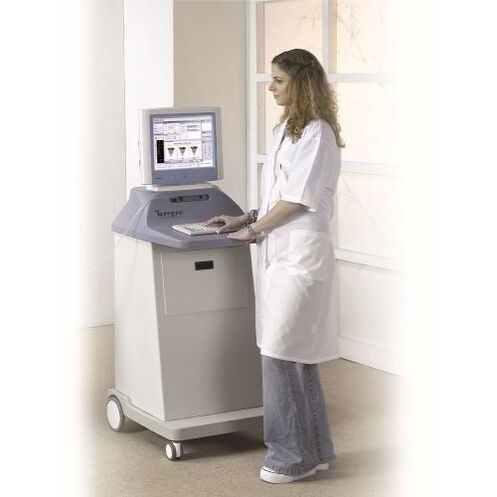Prostatitis is an edema of the tissues of the external tubular alveolar gland. The pathology is manifested only in men, as this gland lies only in the male body.
When the prostate becomes infected, it puts pressure on the urethra and the male body is unable to urinate, which is a major sign of the development of prostatitis. Therapy for this pathology can only be performed after an accurate diagnosis of the type and form of the disease, as treatment methods vary.
Apparatus and instruments for treating prostatitis
Urologists recommend devices for treating prostatitis in an inpatient setting or for personal use. Due to the overall effect on the area of the disease, the effectiveness of the therapy is significantly increased.
There are several special tools for treating the pathology in question:
- Electrical applianceswhich act on the inflamed tissues with an electrical impulse. The main effect on the walls of blood vessels, improves blood circulation, tissue metabolism and regenerates prostate cells.
- Vibroacoustic devices, which are based on the effect of vibrations on the external tubular-alveolar gland, relax the glandular muscles.
- Magnetotherapyalso used in physiotherapy. Today, such treatment is widespread. It reduces swelling, relieves pain and improves blood circulation.
- Laser therapyIt is based on an infrared laser effect on inflamed external tissues with soft rays, performed only by professionals.
Devices for the treatment of pathology have a positive effect on the various types and forms of the disease and on the prevention of relapses. Experts ensure that treatment with such devices helps the patient achieve the desired healing quickly.
Modern medicine is evolving rapidly. Now, devices for treating prostatitis have a rapid healing effect that is achieved in a short time.
One such effect is the ability to use devices to remove the benign formation that affects the gland, which is an acute form of inflammation. This has a qualitative preventive effect on the reappearance of the pathology.
In addition, devices for the treatment of prostatitis provide an opportunity to attenuate or eliminate the signs of the disease that occur during the chronic period of its passage. In addition, a number of tools and devices give visible results after the first procedure.
Indications for use and contraindications
Hardware procedures are recommended only in the area of the urogenital azygos muscle located between the genitals and the anus.
Indications for the use of devices to treat prostatitis include:
- Chronic form of the disease.
- Infectious granulomatous form of the disease.
- Adhesion and contraction of the tissues of the external tubular-alveolar gland.
- Disorders associated with nervous system disorders.
- The difficulty of venous blood outflow is normalized by arterial blood flow in the small pelvis.
- Decreased sexual desire.
- Failures in the process of removing urine from the urethra.
- Sexual dysfunction (impotence).
Special therapeutic devices used to treat the disease should not be used recklessly. Their influence cannot be without results. Inflamed tissue will always be affected and under certain conditions the result may be negative.
Contraindications to the use of the devices are the following factors:
- It is an advanced stage of hemorrhoids.
- Colon enlargement.
- Purulent inflammation of the pelvic tissue.
- Pathological formations.
- Rectal prolapse.
- Blood clotting disorders.
- Damage to the anus.
- Acute pathologies of the organs of the urinary system.
- Solid deposits in the ducts of the gland.
Also contraindicated is the intolerance of physiotherapeutic treatment methods based on rectal injection into the body cavity. In this case, therapy is prescribed by external mechanisms. They are not so popular because their use has less of an effect than invasive devices.
The most popular tools
There are two types of tools for treating prostatitis:
- Rectal physiotherapy devices are designed to massage tissues through the anus.
- Minimally invasive devices are designed for external exposure.
There are only a lot of tools and equipment. They differ in the type of design and the type of collision.
Among the most common models, we distinguish the following:
Combined device
The device acts on inflamed tissues through electrical impulses, magnetic fields, and low-frequency vibrations. Pretty compact. Due to the specificity of the combination of the three exposure combinations, it allows the treatment of the disease at different stages and forms.
Device - massager
It has become a novelty in the treatment of prostate diseases. It is easy to use and can be connected to a computer and has several electrodes with different voltages. It generates laser beams and a magnetic field.
As a result of the complex effect, the density of the blood decreases, the tissues are saturated with oxygen, and the muscles of the pelvis are activated.
Vibrating device
It is a fairly compact device consisting of a control panel, an accessory and a connecting cable. It acts directly through the anus. It has three effects on inflamed tissues: magnetic, warming, vibrating massage. Eliminates the symptoms of pain, relieves inflammation. Complex treatment with the device and medication is recommended.
Biopolar radio frequency device

Also recommended by experts. Works safely with thermal electrodes. The procedure does not require anesthesia, home treatment with such a device is impossible. The device is designed so that it is not necessary to check the rectal temperature.
Physiotherapy devices
The device is designed to relieve tissue edema on its own or at home. It is based on a vibroacoustic effect and has several modes depending on the frequencies emitted. Restores blood circulation.
Many men over the age of 35 are prone to prostatitis. If you have the first symptoms of the disease, you should see a doctor. This pathology can be eliminated fairly quickly thanks to drug therapy as well as treatment with physiotherapeutic devices. There are many different tools in modern medicine that take into account all types, forms, and individual characteristics of the body.
























